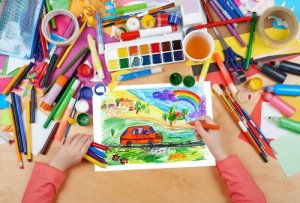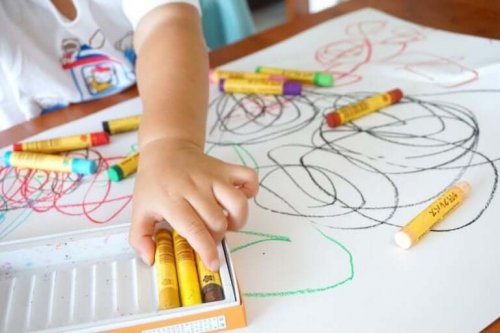6 Benefits of Children Learning to Draw


Written and verified by the psychologist María Alejandra Castro Arbeláez
The benefits of children learning to draw are many and very interesting. Few activities come so naturally to children from a young age as drawing does. These benefits can originate from drawing with chalk on a sidewalk or even from using color pencils on reused paper.
Along with other forms of creative expression, such as dancing or acting, drawing has many benefits for child development. When children draw, they’re enjoying the act of being art creators. In this article, we’ll see some of the benefits of children learning to draw.
Learning to draw develops fine motor skills
Fine motor skills involve any specialized movement of the hands, wrists, and fingers. As adults, we tend to rely on these fine motor skills when we write, drive, or user our cell phones. It’s important that children develop these skills at an early age.
Holding and handling drawing tools is a great way to improve a child’s fine motor skills. The drawing creates immediate visual feedback that changes depending on the tool the kids use and how they use it. This helps them identify the best ways to achieve the desired result.
Encouraging visual analysis is one of the benefits of children learning to draw
Young children still don’t understand certain concepts that older people can take for granted. This includes distance, size comparison, perspective, or texture differences. Drawing provides the perfect opportunity for a child to discover and learn these concepts in a fun way.

Having a child draw specific objects, while relating to others, can help the child perform a basic visual analysis of everyday things. To support this type of drawing at home, we can ask our children to draw concrete things. For example:
- Big things and small items.
- Something rough or smooth.
- Anything that is far and another object that’s close.
Helps kids concentrate
Since most children like to draw, this activity allows them to work on their concentration and practice in a relaxed way. These concepts are very important for academic success, starting at primary education.
Learning to observe small details, concentrating on achieving a result, or practicing difficult tasks helps them mature.
Improves oculo-manual coordination
In addition to improving fine motor skills, drawing allows kids to create connections between what they see and what they do. This eye-hand coordination is a complex cognitive skill. It consists of guiding hand movements according to visual stimuli and feedback.
The development of oculo-manual coordination is very important for the normal development of children and their school learning. To improve eye-hand coordination through drawing, we can ask them to draw an object while looking at it. It can also be useful to encourage them to copy a drawing that was made by us.
Increased confidence is among the benefits of children learning to draw
As parents, guardians, or educators we love hearing children say phrases like “Look at what I did!” When children have the opportunity to create representations from their imagination, they gain self-confidence.
For this reason, learning to draw can help children feel great motivation. It also increases their self-esteem and the feeling of being valued. This will give them more confidence in other areas that may not come as naturally as drawing does.
Teaches a way to solve problems creatively
Learning to draw offers many benefits to children, among them is an increase in the ability to solve problems creatively. When they draw, kids must complete concrete things creatively. For example, they must learn to determine the best way to connect body parts or represent emotions.
So, providing specific drawing tasks, such as encouraging them to create a family portrait or talking about colors, can help children develop skills that also help solve other problems over time.

If we want to make children feel motivated to learn how to draw, we must use positive reinforcement. For example, we can make an exhibition of the drawings in their room or in other areas of the house. Another idea would be to include personalized drawings in letters to family members. Lastly, praise them for practicing and for achieving specific goals.
For children to get the benefits of learning to draw, it’s important to encourage them to do so throughout their childhood. Thus, we’ll reap all these benefits in a simple and natural way. Whether at home, in a nursery school, or in primary education, we’ll see that there are many reasons to encourage children to draw.
The benefits of children learning to draw are many and very interesting. Few activities come so naturally to children from a young age as drawing does. These benefits can originate from drawing with chalk on a sidewalk or even from using color pencils on reused paper.
Along with other forms of creative expression, such as dancing or acting, drawing has many benefits for child development. When children draw, they’re enjoying the act of being art creators. In this article, we’ll see some of the benefits of children learning to draw.
Learning to draw develops fine motor skills
Fine motor skills involve any specialized movement of the hands, wrists, and fingers. As adults, we tend to rely on these fine motor skills when we write, drive, or user our cell phones. It’s important that children develop these skills at an early age.
Holding and handling drawing tools is a great way to improve a child’s fine motor skills. The drawing creates immediate visual feedback that changes depending on the tool the kids use and how they use it. This helps them identify the best ways to achieve the desired result.
Encouraging visual analysis is one of the benefits of children learning to draw
Young children still don’t understand certain concepts that older people can take for granted. This includes distance, size comparison, perspective, or texture differences. Drawing provides the perfect opportunity for a child to discover and learn these concepts in a fun way.

Having a child draw specific objects, while relating to others, can help the child perform a basic visual analysis of everyday things. To support this type of drawing at home, we can ask our children to draw concrete things. For example:
- Big things and small items.
- Something rough or smooth.
- Anything that is far and another object that’s close.
Helps kids concentrate
Since most children like to draw, this activity allows them to work on their concentration and practice in a relaxed way. These concepts are very important for academic success, starting at primary education.
Learning to observe small details, concentrating on achieving a result, or practicing difficult tasks helps them mature.
Improves oculo-manual coordination
In addition to improving fine motor skills, drawing allows kids to create connections between what they see and what they do. This eye-hand coordination is a complex cognitive skill. It consists of guiding hand movements according to visual stimuli and feedback.
The development of oculo-manual coordination is very important for the normal development of children and their school learning. To improve eye-hand coordination through drawing, we can ask them to draw an object while looking at it. It can also be useful to encourage them to copy a drawing that was made by us.
Increased confidence is among the benefits of children learning to draw
As parents, guardians, or educators we love hearing children say phrases like “Look at what I did!” When children have the opportunity to create representations from their imagination, they gain self-confidence.
For this reason, learning to draw can help children feel great motivation. It also increases their self-esteem and the feeling of being valued. This will give them more confidence in other areas that may not come as naturally as drawing does.
Teaches a way to solve problems creatively
Learning to draw offers many benefits to children, among them is an increase in the ability to solve problems creatively. When they draw, kids must complete concrete things creatively. For example, they must learn to determine the best way to connect body parts or represent emotions.
So, providing specific drawing tasks, such as encouraging them to create a family portrait or talking about colors, can help children develop skills that also help solve other problems over time.

If we want to make children feel motivated to learn how to draw, we must use positive reinforcement. For example, we can make an exhibition of the drawings in their room or in other areas of the house. Another idea would be to include personalized drawings in letters to family members. Lastly, praise them for practicing and for achieving specific goals.
For children to get the benefits of learning to draw, it’s important to encourage them to do so throughout their childhood. Thus, we’ll reap all these benefits in a simple and natural way. Whether at home, in a nursery school, or in primary education, we’ll see that there are many reasons to encourage children to draw.
All cited sources were thoroughly reviewed by our team to ensure their quality, reliability, currency, and validity. The bibliography of this article was considered reliable and of academic or scientific accuracy.
- Goodnow, J. (1979). El dibujo infantil (Vol. 8). Ediciones Morata.
- Muños-Hidalgo, M. D. (2014). El dibujo infantil: La etapa preesquemática. http://tauja.ujaen.es/bitstream/10953.1/796/4/TFG_MuñozHidalgo%2cMar%C3%ADaDolores.pdf
- Lowenfeld, V. & Brittain, W. L. (1980). Desarrollo de la capacidad creadora (2a Ed.). Buenos Aires: Kapelusz.
- Cordera, M., Bertolez, A., Monesterolo, L., & Herrera, M. El dibujo infantil como expresión de desarrollo saludable.
- Acaso, M. (2000). Simbolización, expresión y creatividad: tres propuestas sobre la necesidad de desarrollar la expresión plástica infantil. Arte, individuo y sociedad, (12), 41. https://revistas.ucm.es/index.php/ARIS/article/download/ARIS0000110041A/5919
This text is provided for informational purposes only and does not replace consultation with a professional. If in doubt, consult your specialist.








